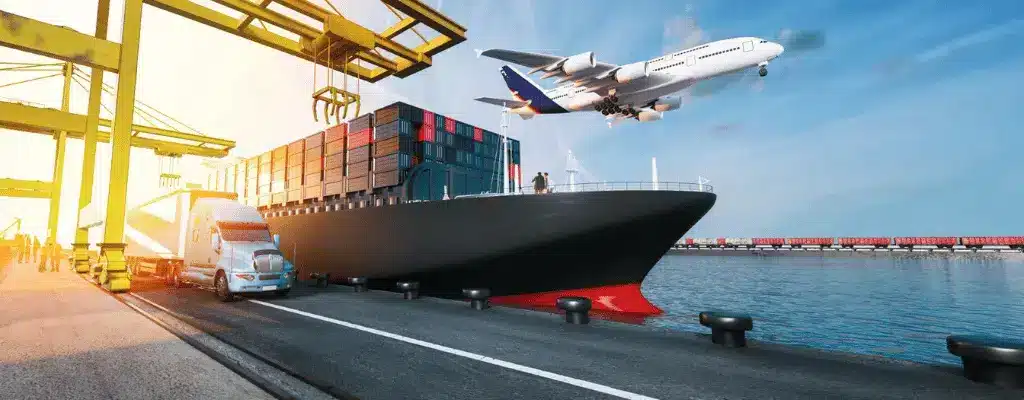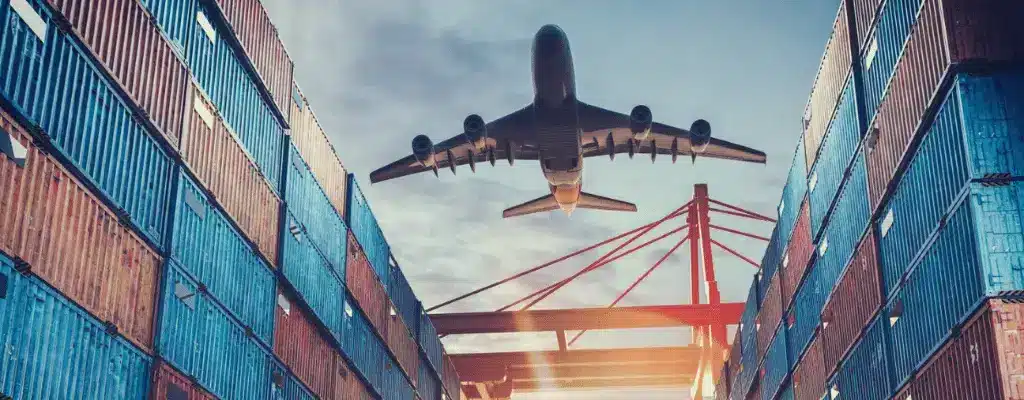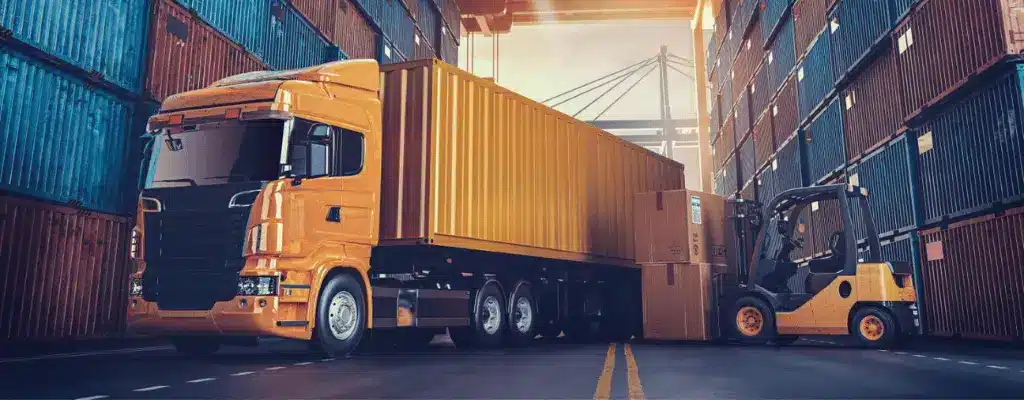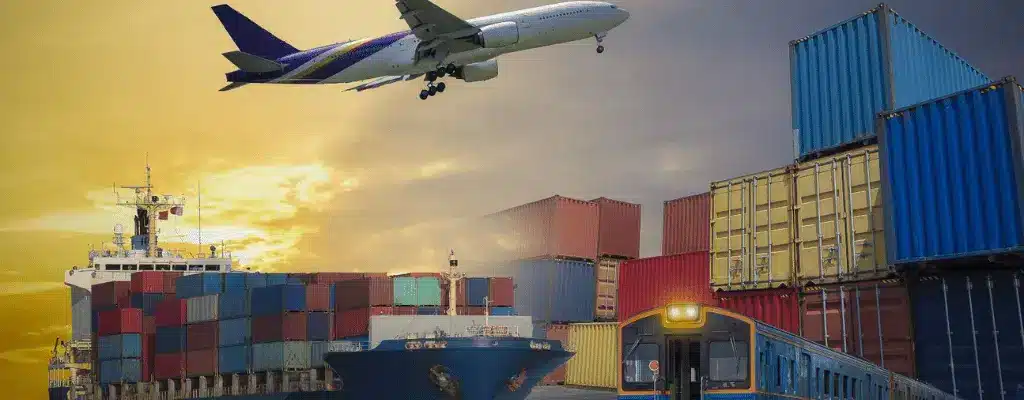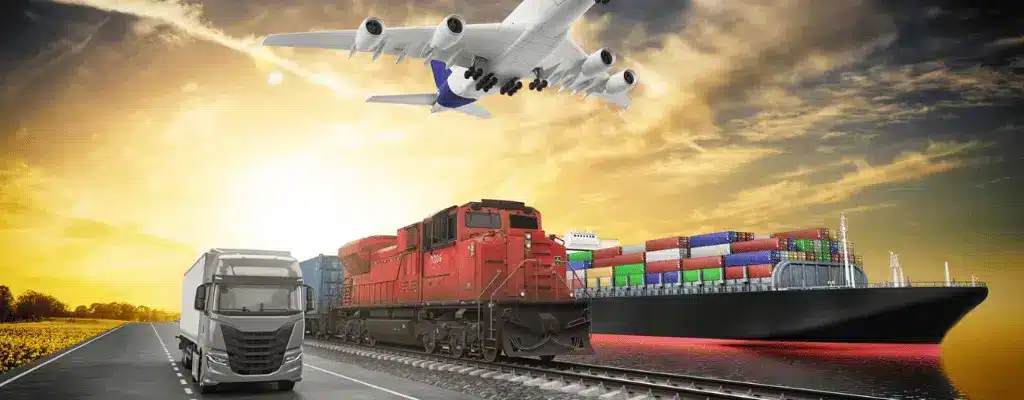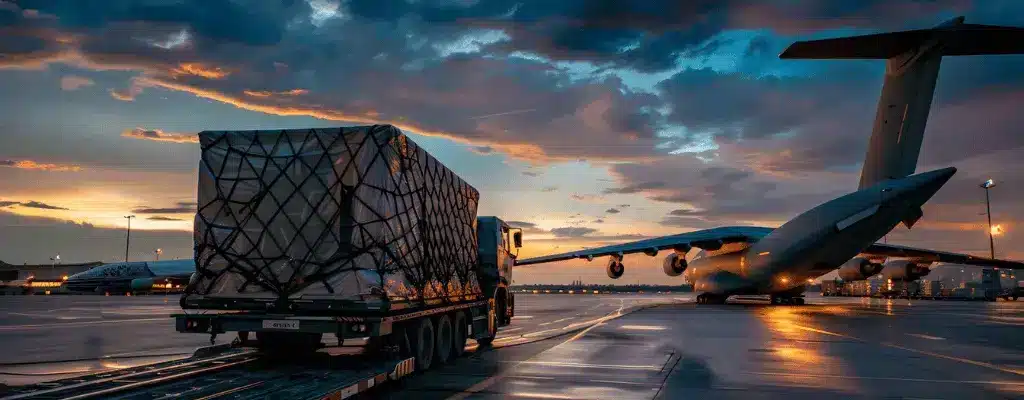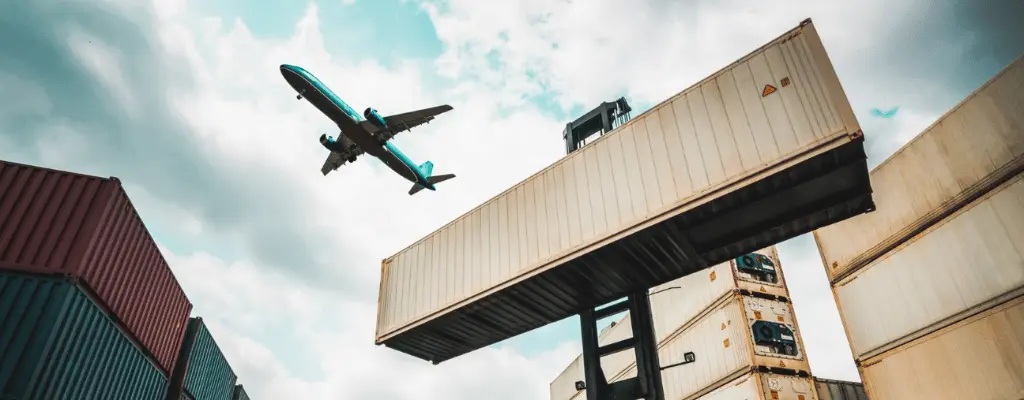In today’s globalized business world, speed, flexibility, and cost optimization are the keys to success. Relying solely on traditional, single-mode transportation methods is no longer sufficient. This is where multimodal transportation, as a smart and efficient solution, comes into play.
Imagine your valuable shipment needing to travel from the heart of production in China to a consumer in Iran. For this long journey, you have several options: fast but expensive air freight, economical but time-consuming sea freight, or land transport with its own limitations. But what if you could intelligently combine the advantages of each method?
Multimodal transportation does exactly that. This innovative logistics approach, leveraging the strengths of various transportation modes (sea, land, air), revolutionizes your supply chain and helps you achieve your business goals with speed, security, and optimal cost.
Mobin Asa Tarabar, as an international logistics expert, is with you on this journey, offering smart multimodal transportation services. With a deep understanding of the challenges of global trade and relying on our experience and technical knowledge, we design and implement the best multimodal transport solutions for your business.
In this comprehensive article, we will explore the various aspects of multimodal transport and reveal its numerous benefits for today’s businesses. Join us to open a new window to smart logistics and successful global trade.
What is Multimodal Transportation?
Multimodal transportation, sometimes also known as combined transport or intermodal transport, is more than just a simple method of transportation; it is a smart strategy for moving goods in the global supply chain. This method uses a combination of two or more different modes of transport to move a single shipment from the origin to the final destination, while the goods, throughout the journey, do not need to be unloaded and reloaded from their original container.
Definition and Types of Multimodal Transportation
Simply put, imagine your goods are first transported by sea freight from China to a port in Europe. Then, the same container, without being opened, is loaded onto a train and transported to a destination in Eastern Europe. Finally, a truck is used to reach the final warehouse. This is a clear example of multimodal transport.
Common types of multimodal transportation include:
- Sea-Land: Combining sea freight for long distances and land transport (truck or train) for final distribution to inland destinations. This method is particularly useful for transporting goods from Asia to Europe and vice versa.
Container ship and truck unloading cargo
- Air-Land: Combining air freight for time-sensitive segments and land transport to reduce costs over the remaining distances. This method is suitable for valuable goods and precise schedules.
Airplane and truck transporting goods
- Other Transport Combinations (Rail-Land, Inland Waterway-Land): Depending on the route and type of goods, other combinations such as rail and land transport, or inland waterway and land transport can also be used.
Advantages of Using Multimodal Transportation
Why has multimodal transport become an attractive option for businesses? The reason is the significant advantages this method offers compared to single-mode transport:
- Cost Optimization: By intelligently choosing a combination of transportation methods, you can benefit from more economical tariffs of sea and rail transport over long distances and significantly reduce overall transportation costs.
- Increased Speed and Improved Delivery Time: While sea freight is economical, it can be time-consuming. Multimodal transport, using air or land transport in parts of the route, can increase the overall transport speed and improve delivery time.
- Greater Flexibility in Choosing Transport Methods: Multimodal transport offers you greater flexibility in choosing the route and modes of transport. You can choose the best combination based on the type of goods, your budget, and your schedule.
- Risk Reduction and Increased Cargo Security: By reducing the number of loading and unloading operations, the risk of damage and loss of goods is significantly reduced. The use of sealed containers also helps to increase cargo security.
- Access to Wider Global Markets: Multimodal transport provides access to wider geographical areas, especially areas that do not have direct access to international ports or airports.
Differences Between Multimodal Transport and Other Modes
Understanding the difference between multimodal transport and other methods helps you better understand its true value:
| Characteristic | Road Transport | Rail Transport |
|---|---|---|
| Accessibility | High; reaches most locations. | Limited to rail network; requires intermodal connections. |
| Flexibility | High; adaptable scheduling and routing. | Lower; fixed schedules and routes. |
| Capacity | Lower than rail or sea. | High; suitable for bulk and large volumes. |
| Cost | Economical for short/medium distances & LTL. | Economical for long distances & large volumes. |
| Speed | Faster for short/medium distances. | Slower for short distances, faster for long hauls. |
| Safety | Moderate | High |
| Best For | Short/medium hauls, LTL, door-to-door delivery | Long hauls, bulk cargo, heavy shipments |
As you can see, multimodal transport is a comprehensive and smart solution that offers numerous advantages for businesses. In the following sections, we will examine the key benefits of this method for your business and Mobin Asa Tarabar’s services in this area.
Key Benefits of Multimodal Transport for Businesses
Multimodal transport, beyond being a logistics strategy, is a competitive advantage for businesses operating in the global trade arena. In this section, we will examine the key benefits of multimodal transport in detail and show how this method can help your business grow and succeed.
Reducing Transportation Costs
One of the most prominent benefits of multimodal transportation is the significant reduction in transportation costs. By intelligently combining different methods, you can benefit from more competitive rates for each mode in different parts of the route. For example:
- Using Sea Freight for Long Distances: Sea freight is generally the most economical way to move large volumes of goods over long distances. Combining it with other methods allows you to benefit from this advantage for the majority of the route.
- Optimizing Route and Mode of Transport: Choosing the right combination helps you avoid paying extra costs for faster transport for the entire route (if not needed). For example, for goods that are less urgent, you can travel most of the way by sea and the final leg by land.
- Reducing Ancillary Costs: With integrated transport management by a single company (like Mobin Asa Tarabar in combined services), costs related to coordination between different transport companies, transferring goods between different modes, and potential temporary warehousing costs are reduced.
Increasing Speed and Improving Delivery Time
While sea and land transport are cost-effective options, air freight is very suitable for time-sensitive goods due to its high speed. Multimodal transport, taking advantage of these features, helps you:
- Speed Up Delivery Time in Sensitive Segments: For parts of the route where delivery speed is critical (such as delivering essential spare parts to a production line or delivering prototypes to customers), you can use air freight in combination with other methods.
- Improve Overall Scheduling: Precise planning and coordination between different modes in multimodal transport leads to more accurate delivery time prediction and reduces potential delays.
- Respond to Urgent Customer Needs: By offering diverse combination options, you can respond to different customer needs in terms of speed and cost and increase their satisfaction.
Greater Flexibility in Choosing Transport Methods
Every business has its own specific transportation needs. Multimodal transport, by offering unparalleled flexibility in choosing methods and routes, allows you to:
- Customize the Transport Solution: You can choose the best transport combination based on the type of goods, their value, distance, budget, and your schedule. Mobin Asa Tarabar will assist you in this choice by providing expert advice.
- Adapt to Changing Conditions: In the dynamic world of business, conditions change rapidly. Multimodal transport allows you to quickly react to changes and adjust your transport method based on new conditions.
- Access Areas with Limited Infrastructure: Multimodal transport allows you to access areas that have limited access to a particular type of transport infrastructure. For example, to send goods to inland areas without an international airport, you can use a combination of sea and land transport.
Risk Reduction and Increased Cargo Security
Cargo security has always been a major concern for business owners. Multimodal transport, by reducing vulnerabilities in the supply chain, helps to increase security and reduce the risk to your cargo:
- Reduced Number of Loading and Unloading Operations: By keeping the goods in the original container during long transport routes, the risk of damage, breakage, and loss of goods is significantly reduced.
- Use of Sealed Containers: Containers provide good physical protection against environmental factors and theft. Using standard containers in multimodal transport helps to increase cargo security.
- Integrated Management and Single Responsibility: In multimodal transport, responsibility for transport rests with a single company (like Mobin Asa Tarabar). This facilitates cargo tracking and accountability in case of problems and eliminates the risks associated with coordination between different companies.
Access to Wider Global Markets
Finally, multimodal transport gives you access to wider global markets. By combining different methods, you will no longer be limited to coastal areas or areas near major airports. You can:
- Send Goods to Remote Inland Areas: Multimodal transport makes it possible to access inland areas of countries that lack sea or air transport infrastructure. For example, you can transport goods by sea to a European port and then use land transport to send them to the heart of Europe.
- Develop Export and Import Markets: By reducing costs and increasing transport speed, you can explore new export and import markets and expand the scope of your business.
- Be More Competitive in Global Markets: By taking advantage of the benefits of multimodal transport, you can reduce your logistics costs and perform better in competitive global markets.
Types of Multimodal Transportation Methods
Multimodal transport opens up a world of possibilities for businesses. The variety of transport combinations allows you to choose exactly the method that matches the specific needs of your cargo, budget, and schedule. In this section, we will examine the most common types of multimodal transport and their applications.
Sea-Land Transport
Sea-Land transport is one of the most common and cost-effective combinations of multimodal transport in global trade. This method combines the advantages of sea transport over long distances with the flexibility and wide accessibility of land transport.
How it works:
- Sea Transport: Your cargo is transported by container ships from the port of origin (e.g., ports in China or Europe) to an intermediate port (such as ports in Iran, Turkey, or European ports).
Container ship at port
- Transfer to Land Transport: At the intermediate port, the container is unloaded from the ship and directly loaded onto a truck or train. Without opening the container and unloading the goods.
- Land Transport: The truck or train transports the container to the final destination in inland areas of the country or neighboring countries.
Container truck on highway
Advantages:
- Most Cost-Effective Option for Long Distances: Benefiting from the low tariffs of sea transport on the main part of the route.
- High Cargo Capacity: Ability to move large volumes of goods using large ships.
- Extensive Land Access: Ability to distribute goods to inland areas without direct access to ports.
- Suitable for Various Goods: Can be used to transport various goods, from general cargo to machinery and raw materials.
Disadvantages:
- Relatively Long Transit Time: Compared to air transport, the transit time is longer.
- Dependence on Port and Land Infrastructure: Utilizing this method requires the existence of suitable ports and efficient road and rail networks along the route.
Applications:
- Transporting Goods from Asia to Europe and Vice Versa: Transit routes through Iran, Turkey, and Russia.
- Transporting Goods to Inland Areas of Countries: Distribution of goods from coastal ports to inland cities.
- Transporting Non-Urgent and High-Volume Goods: Suitable for goods where delivery time is not the top priority and transport cost is more important.
Air-Land Transport
Air-Land transport is an ideal combination for time-sensitive shipments. This method combines the high speed of air transport with the more cost-effective costs of land transport over shorter distances.
How it works:
- Air Transport: The first part of the route is carried out using cargo aircraft. The cargo is quickly transported to an international airport near the final destination.
Cargo airplane taking off
- Transfer to Land Transport: At the airport, the cargo is quickly transferred to trucks specially designed for air cargo transport.
- Land Transport: The truck transports the cargo to the final destination, which may be an inland city, warehouse, or distribution center.
Advantages:
- Very High Speed on the Main Part of the Route: Air transport is the fastest method of international transport.
- Cost Reduction Compared to Pure Air Transport: Using land transport for short final distances reduces the overall cost.
- Suitable for Valuable Goods and Precise Schedules: The best option for goods that require fast delivery.
- Access to Areas Without an International Airport: Goods can be transported to the nearest international airport and then transported to the final destination by land.
Disadvantages:
- Higher Cost Compared to Sea and Land Transport: The overall cost is still higher than the sea-land combination.
- More Limited Cargo Capacity: Compared to ships and trains, airplanes have a lower cargo capacity.
- Air Transport Cargo Restrictions: Some goods cannot be transported by air due to safety issues or dimensions.
Applications:
- Transporting Prototypes and Display Goods: Fast delivery to potential customers at exhibitions and trade events.
- Transporting Spare Parts and Essential Equipment: Quickly delivering parts to prevent production line stoppages or for urgent repairs.
- Transporting Perishable and Pharmaceutical Goods: Maintaining the quality and effectiveness of goods by reducing transport time.
- Transporting High-Value and Low-Volume Goods: Such as jewelry, expensive electronic components, and important documents.
Other Transport Combinations (Rail-Land, Inland Waterway-Land)
In addition to sea-land and air-land combinations, depending on the specific conditions of the route and the type of goods, other combinations are also used in multimodal transport:
- Rail-Land Transport: Combining rail transport for medium and long distances on land with land transport for final distribution. This method is common in areas with extensive and efficient rail networks (such as Europe and Russia).
Cargo train carrying containers
- Inland Waterway-Land Transport: Combining transport with river and canal ships with land transport. This method is used in areas with extensive waterway networks (such as Europe and North America) and can be very cost-effective.
Barge on river carrying cargo
Comparison Table of Multimodal Transport Methods:
| Transport Mode Combination | Key Advantages | Key Disadvantages | Best Use Cases |
|---|---|---|---|
| Sea-Land | High capacity, cost-effective for long distances, extensive inland reach. | Longer transit times, reliant on port & land infrastructure. | Asia-Europe trade, bulk goods, non-urgent shipments, inland distribution. |
| Air-Land | Fastest option, reduced cost vs. all-air, good for final-mile delivery. | More expensive than sea-land, limited cargo capacity. | Time-sensitive goods, high-value items, urgent spare parts, perishables, samples. |
| Rail-Land | Cost-effective for overland transport, high capacity. | Limited to areas with rail infrastructure, less flexible routing. | Intra-continental (Europe, Russia, etc.), medium-volume/distance shipments, bulk commodities. |
| Inland Waterway-Land | Lowest cost per ton-mile, environmentally friendly. | Slowest speed, limited to areas with navigable waterways. | Bulk materials, low-value goods, non-urgent shipments in regions with waterway networks. |
In the next section, we will examine in more detail the multimodal transport services offered by Mobin Asa Tarabar and the advantages of choosing this company as your logistics partner.
Multimodal Transport at Mobin Asa Tarabar
Mobin Asa Tarabar, with a deep understanding of the benefits of multimodal transport and the growing need of businesses for smart logistics solutions, offers comprehensive and customized multimodal transport services to its customers. By leveraging our expertise, experience, and extensive network of international partners, we design and implement the best transport combinations for your shipments so that you can achieve your business goals with maximum efficiency and minimum cost.
For Which Businesses are Mobin Asa’s Multimodal Transport Services Suitable?
Mobin Asa’s multimodal transport services are suitable for a wide range of businesses and industries that are active in international trade in goods. In particular, these services are suitable for companies that:
- Are looking to reduce their logistics costs: Multimodal transport, by optimizing the route and modes of transport, helps to significantly reduce your costs.
- Value speed and precise scheduling in the delivery of their shipments: We respond to your sensitive scheduling needs by offering smart combinations of fast and economical methods.
- Need flexibility in choosing transport methods: Our services allow you to choose the best transport combination based on the type of goods, budget, and specific conditions.
- Have shipments with special characteristics: Whether your goods are bulky, heavy, dangerous, or temperature-sensitive, we offer the appropriate multimodal transport solution.
- Operate in extensive global markets: Our wide network of partners around the world provides you with access to remote markets and areas with limited infrastructure.
- Need a reliable and specialized logistics partner: Mobin Asa Tarabar, with its brilliant track record and experienced team, will be by your side as a reliable partner to manage all stages of multimodal transport of your shipments in the best possible way.
Advantages of Choosing Mobin Asa for Multimodal Transport
Choosing Mobin Asa Tarabar as your logistics partner in multimodal transport has numerous advantages:
- Expert Consultation and Customized Solution Design: Our experienced experts, by carefully examining your needs, design the best multimodal transport combination for your shipment.
- Extensive International Network: Cooperation with reputable shipping lines, airlines, and land transport companies around the world provides extensive coverage for our services.
- Integrated Management and Full Coordination: We manage all stages of multimodal transport from the origin to the final destination in an integrated manner and take full responsibility for transporting your shipment.
- Transparency and Accurate Information: We provide you with accurate and up-to-date information at all stages of transport and provide the ability to track and trace your shipment in real-time.
- Compliance with International Standards: Mobin Asa Tarabar adheres to the highest global standards in the transport and logistics industry and guarantees the safety and security of your shipment.
- Competitive and Fair Pricing: By offering optimized and efficient solutions, we provide you with the best prices for multimodal transport services.
- Committed Customer Support: Our customer support team is always ready to answer your questions and resolve any potential issues during the transport process.
Routes Covered by Mobin Asa Multimodal Transport
Mobin Asa Tarabar, with extensive coverage of international routes, provides multimodal transport services to various destinations. Some of the key routes covered by us include:
- Asia-Europe Trade Routes and Vice Versa: Using a combination of sea transport from ports in China and Southeast Asia to European ports and land transport via Iran, Turkey, and Russia to inland destinations in Europe and CIS countries.
- Europe-Iran and Neighboring Countries Trade Routes: Combining sea or air transport from Europe to ports and airports in Iran and land transport to various cities in Iran and countries in the region.
- Domestic and Regional Routes: Combining land transport by train or truck to move goods within a country or between neighboring countries.
- Special and Customized Routes: We are also prepared to design and implement multimodal transport routes based on your specific needs and unusual destinations.
Successful Examples of Multimodal Transport by Mobin Asa
Mobin Asa Tarabar has a brilliant track record in providing successful multimodal transport services to various industries and businesses. Some examples of successful multimodal transport projects carried out by us include:
- Transporting Heavy Industrial Equipment from Europe to Iran: Combining sea transport for the main part of the route and specialized land transport for moving extra-heavy shipments to the installation site in Iran.
- Transporting Raw Materials from China to Manufacturing Factories in Eastern Europe: Using a combination of sea transport from Chinese ports to Black Sea ports and rail transport to final destinations in Eastern Europe.
- Transporting Perishable Goods from Iran to Russia: Combining air transport for time-sensitive segments and refrigerated land transport to maintain the quality of goods over the remaining distances.
These examples are just a glimpse of Mobin Asa Tarabar’s capabilities in the field of multimodal transport. We are ready to offer the best multimodal transport solution for your business, relying on our experience and expertise.
How to Calculate the Cost of Multimodal Transport
Calculating the cost of multimodal transport, due to its multi-faceted and combined nature, is more complex than single-mode methods. Several factors influence the final price, and to get an accurate estimate, you need to review the details of the shipment and the transport route. In this section, we will examine the factors affecting the cost of multimodal transport and how to request a quote from Mobin Asa Tarabar.
Factors Affecting the Cost of Multimodal Transport
The cost of multimodal transport is influenced by various factors, which can generally be divided into the following categories:
- Shipment Characteristics:
- Type of Goods: The type of goods (general, dangerous, perishable, etc.) has a significant impact on the cost. Transporting special goods, such as dangerous goods, requires special arrangements and permits, which increases the cost.
- Weight and Volume: The weight and volume of the shipment directly affect the transport cost. Heavier and bulkier shipments entail higher costs.
- Value of Goods: The value of the goods may affect the cost of insurance and liability for transport.
- Dimensions and Packaging: Shipments with non-standard dimensions or requiring special packaging may have higher costs.
- Transport Route:
- Origin and Destination: The distance between the origin and destination is the most important factor in determining the transport cost. Longer routes have higher costs.
- Selected Multimodal Transport Methods: The combination of transport methods (sea-land, air-land, etc.) has a significant impact on the cost. Faster combinations (such as air-land) are usually more expensive.
- Fuel Costs and Tolls: Fluctuations in fuel prices and road and port tolls can affect the final cost.
- Seasonal and Weather Conditions: In some routes, adverse weather conditions or the seasonality of routes (such as North Sea routes in winter) may increase costs.
- Additional Services:
- Customs Services (if requested): Although Mobin Asa Tarabar does not provide customs clearance services, coordination with customs brokers and providing the required documents may involve costs.
- Cargo Insurance (if requested): Cargo insurance has a separate cost, which is determined based on the value of the goods and transport conditions.
- Special Services (if needed): Additional services such as transporting oversized cargo, transporting dangerous goods, special packaging, etc., will have separate costs.
- Transport Company:
- Expertise and Experience: Transport companies with experience and expertise in multimodal transport may have different rates. Mobin Asa Tarabar’s expertise in this field is a value-added that is reflected in the pricing of our services.
- Network and Coverage: The extent of the transport company’s network and geographical coverage affects its ability to provide services on different routes and, consequently, competitive pricing.
- Level of Customer Service: The quality of customer service, support, and transparency provided by the transport company are among the factors that can be effective in your choice and understanding the value of the price paid.
How to Request a Quote from Mobin Asa Tarabar
To receive the most accurate and up-to-date price for multimodal transport of your shipment from Mobin Asa Tarabar, we recommend that you contact us through one of the following methods:
- Phone Call to Sales Experts: The simplest and fastest way is to call our experienced sales experts. You can call the phone numbers listed in the “Contact Us” section of the Mobin Asa Tarabar website and provide the basic information about your shipment. Our experts will quickly provide an initial price estimate after reviewing your information and, if necessary, guide you to provide additional information.
- Submitting the Online Quote Request Form: On the Mobin Asa Tarabar website, an online quote request form is available to you. By visiting this form and completing the information related to the shipment, origin, destination, type of services required, and your contact information, submit your quote request. Our experts will review your request as soon as possible and contact you. We suggest that you provide accurate and complete information in the form as much as possible to speed up the quote process.
- Sending an Email: You can send your quote request along with complete shipment information and your needs to the email address listed in the “Contact Us” section of the Mobin Asa Tarabar website. Our experts will provide the necessary response after reviewing your email.
Information Required for a Quote:
To be able to provide you with the most accurate price, please have the following information ready when requesting a quote:
- Precise Origin and Destination of the Shipment: Including city, country, and if possible, postal code or exact address.
- Type of Goods: A detailed description of the type of goods (e.g., industrial machinery, chemicals, clothing, food, etc.).
- Weight and Volume of the Shipment: Gross Weight and Volume (CBM – cubic meters) of the shipment.
- Packaging Dimensions: Dimensions of each packaging unit (length, width, height) and the number of packages.
- Special Transport Conditions (if any): Does the goods require temperature-controlled transport? Are the goods dangerous? Does it require oversized transport? etc.
- Desired Schedule: Is delivery time a priority for you? Do you have a specific time for delivery?
- Additional Services Required (if any): Do you need cargo insurance, customs services (other than clearance), or other special services?
By providing accurate and complete information, Mobin Asa Tarabar experts will be able to provide you with the best and most accurate price for multimodal transport of your shipment in the shortest possible time and assist you in choosing the most suitable logistics solution.
Frequently Asked Questions (FAQ)
In this section, we will answer some of the frequently asked questions that you may have about multimodal transport and Mobin Asa Tarabar’s services. Our goal is to clarify ambiguities and provide transparent and practical information for your informed decision-making.
1. What are the advantages of multimodal transport compared to direct transport?
Multimodal transport offers several advantages compared to direct (single-mode) transport, the most important of which are:
- Cost Reduction: Intelligently combining transport methods allows you to benefit from the more economical rates of different methods in different parts of the route and reduce the overall transport cost. While direct transport may be more expensive due to using a more expensive method for the entire route.
- Increased Speed and Improved Delivery Time: Multimodal transport, using faster methods in sensitive parts of the route, can improve delivery time and meet more precise scheduling needs. Direct transport usually has limited speed and depends on the speed of the chosen transport method.
- Greater Flexibility: Multimodal transport offers greater flexibility in choosing the route and methods and allows customization of the transport solution based on your specific needs. Direct transport has less flexibility and is limited to the routes and capabilities of one mode of transport.
- Risk Reduction and Increased Security: Reducing the number of loading and unloading operations in multimodal transport reduces the risk of damage and loss of goods and increases the security of the shipment. In direct transport, risks may increase at transfer points between different parts of the route (if multiple companies are used).
- Access to Wider Markets: Multimodal transport provides access to wider geographical areas, especially areas that do not have direct access to international ports or airports. Direct transport may limit access to these areas.
2. How is the cost of multimodal transport calculated?
The cost of multimodal transport depends on several factors, including:
- Type of goods, weight, volume, and value: These specifications determine the type of transport vehicle and safety and insurance considerations.
- Precise origin and destination: Distance and transport route have a direct impact on cost.
- Combination of selected transport methods: The cost of each part of the transport (sea, land, air) is calculated separately and then aggregated.
- Additional costs: Including fuel costs, tolls, loading and unloading, temporary warehousing (if needed), and requested additional services.
- Rates of transport companies: The tariffs of different transport companies (sea, land, air) and market conditions affect the final price.
To receive an accurate estimate of the cost of multimodal transport of your shipment, we recommend contacting Mobin Asa Tarabar experts and providing complete information about your shipment and desired route. Our experts will provide the best and most accurate price after reviewing your information. (For a price quote, refer to the “How to Calculate the Cost of Multimodal Transport” section in this article.)
3. What types of goods does Mobin Asa Tarabar transport multimodally?
Mobin Asa Tarabar is capable of transporting various types of goods multimodally. Our services are not limited to a specific type of goods and include:
- General and Commercial Goods: Clothing, electronics, spare parts, agricultural products, packaged food, etc.
- Machinery and Industrial Equipment: Production lines, construction machinery, agricultural equipment, generators, turbines, etc. (transporting heavy and oversized cargo).
- Raw Materials and Semi-finished Products: Minerals, non-hazardous chemicals, metals, plastics, etc.
- Perishable and Temperature-Sensitive Goods: Fresh food, pharmaceuticals, sensitive agricultural products, etc. (using refrigerated containers and fast transport methods).
- Dangerous Goods: Hazardous chemicals, explosives (in full compliance with safety standards and relevant regulations and obtaining the necessary permits).
However, we recommend that you discuss the type of your goods with Mobin Asa Tarabar experts beforehand to ensure the possibility of multimodal transport and to receive the best transport solution.
4. How can I request a quote for multimodal transport from Mobin Asa Tarabar?
To request a quote from Mobin Asa Tarabar, there are several simple and fast methods available to you:
- Phone Call: Call the phone numbers listed in the “Contact Us” section of the Mobin Asa Tarabar website and speak directly with sales experts.
- Online Quote Request Form: Visit the “Request a Quote” page on our website and carefully complete the relevant form.
- Sending an Email: Send your quote request along with complete shipment information to the company’s email address.
To speed up the quote process and receive the most accurate estimate, please provide complete information about your shipment, including the type of goods, weight, volume, dimensions, origin, destination, and any special transport conditions. Mobin Asa Tarabar experts are ready to answer your questions and provide expert advice on multimodal transport.


